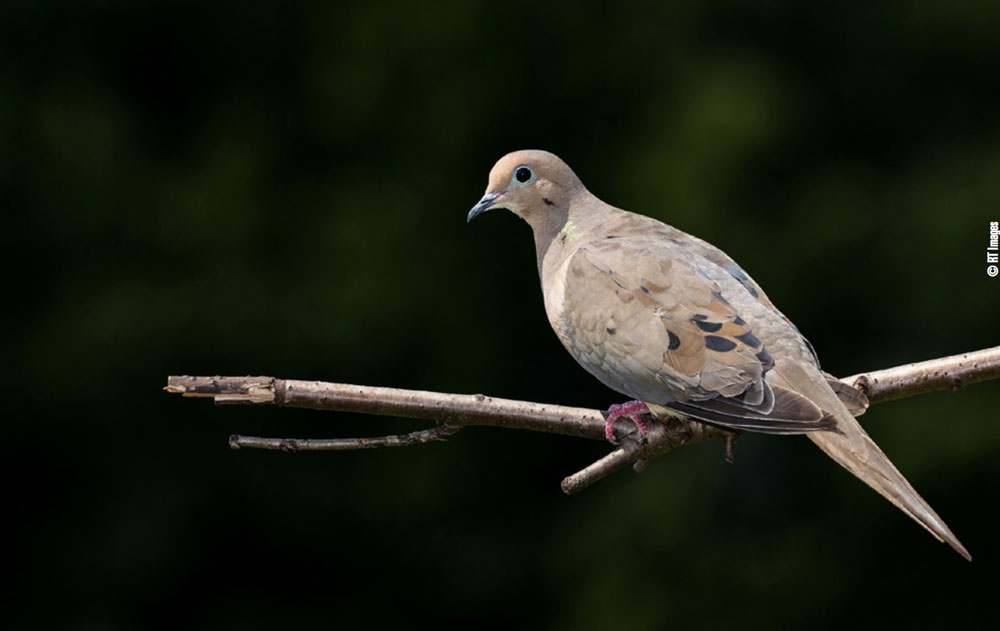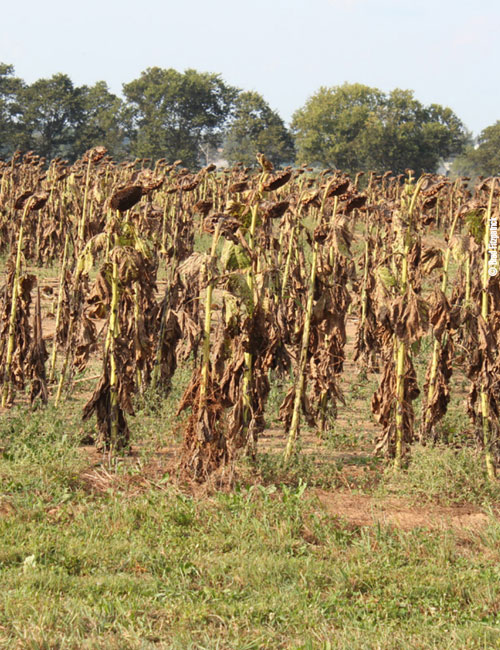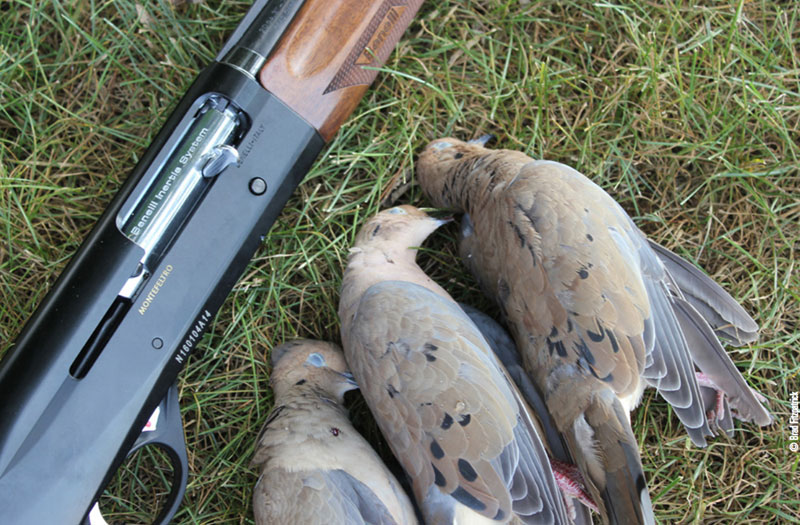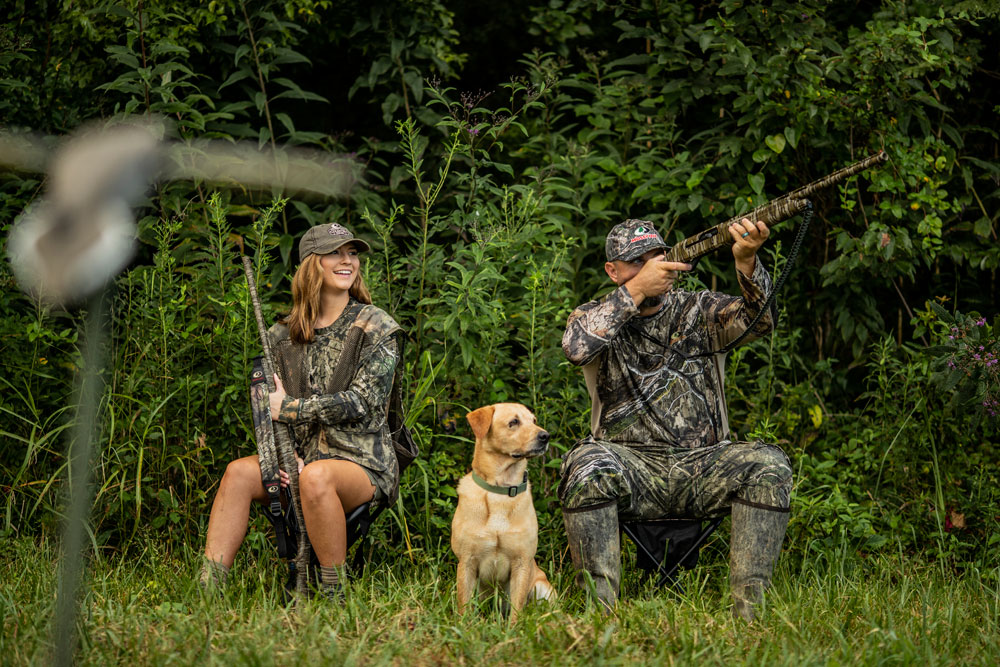
Finding a place to dove hunt in September can be difficult. There are public dove fields in some areas, but on opening morning they are invariably over-crowded. If you have the funds you can join a private hunting club that caters to dove hunters, but all you really need to start shooting limits on your own land is a little time and effort, by planting a productive sunflower field you can bag your limits of birds day after day.
What Makes for Good Dove Hunting?
As settlers began clearing forest lands to create agricultural fields, mourning doves were one of the species that profited from the change. While they prefer a mix of woods and open areas, mourning doves can also be found in areas where there are no trees at all. For that reason, mourning dove numbers have increased dramatically across the country and they are the nation’s most popular game bird. In addition, the mourning doves’ needs are relatively few; they require open ground for feeding, preferably with grit or gravel to help digest their diet that consists almost entirely of seeds, a place to perch and plenty of water. If you have all of these things then you probably have mourning doves already. When you start to plan your dove field, bear these essentials in mind.
Dove Food Plots
 For starters, you’ll need to provide a food source that attracts birds. Traditionally, hunters have chosen sunflowers, and there’s no doubt that this remains the most popular planting when attempting to attract doves, but many hunters are finding that a bit of diversity can actually be helpful in attracting more birds and can make your plot more versatile so that it provides feed for a number of wildlife species. For instance, Mossy Oak BioLogic’s Grain Sorghum is an effective alternative that may actually offer some advantages over traditional sunflower seeds. Whereas sunflower seeds attract doves, turkeys, and a few other species, sorghum actually provides food for doves, quail, turkeys, waterfowl and even whitetails. Plus, sorghum is a natural cover plant for quail, deer and rabbits, so you will find that this plant is the perfect complement to your existing whitetail plots. Sorghum provides high-quality seeds and lots of them, and a single bag will cover an acre or more, making this an affordable alternative to sunflowers.
For starters, you’ll need to provide a food source that attracts birds. Traditionally, hunters have chosen sunflowers, and there’s no doubt that this remains the most popular planting when attempting to attract doves, but many hunters are finding that a bit of diversity can actually be helpful in attracting more birds and can make your plot more versatile so that it provides feed for a number of wildlife species. For instance, Mossy Oak BioLogic’s Grain Sorghum is an effective alternative that may actually offer some advantages over traditional sunflower seeds. Whereas sunflower seeds attract doves, turkeys, and a few other species, sorghum actually provides food for doves, quail, turkeys, waterfowl and even whitetails. Plus, sorghum is a natural cover plant for quail, deer and rabbits, so you will find that this plant is the perfect complement to your existing whitetail plots. Sorghum provides high-quality seeds and lots of them, and a single bag will cover an acre or more, making this an affordable alternative to sunflowers.
It’s important to note that doves won’t feed on ground with heavy vegetation. Instead, you’ll see them picking along disturbed areas like new construction, mowed fields, gravel roads and harvested crop fields. That means the key element to any successful dove field is an open area where the birds can feed effectively and efficiently. For that reason herbicide-based weed control is essential. Dove fields that are weed-free simply require bush hogging near the beginning of the hunting season to produce an ideal environment for feeding birds. If you time your planting right, control weeds during the summer months and offer the birds ample open feeding areas you’ll be surprised at the number of doves that utilize a single field. Dove fields don’t require much space. Obviously larger fields will attract more birds, but even small plots will bring in a few dozen or more on a daily basis. And while you could donate a couple of acres in one location to a bird field, consider splitting your fields into two different locations. This serves several purposes. First, it keeps the birds moving. As birds fly from one field to the next they offer more shot opportunities. Secondly, multiple fields allow you to hunt one field while resting the other. Doves are prolific breeders (they can produce up to six clutches per year, more than any other North American bird), but they are sensitive to hunting pressure. The best option is to offer them multiple options. Even when rotating fields you sometimes apply so much pressure they will avoid the area, especially if multiple hunters are trying to take a limit every day. You’re far better off to rest fields and hunt each one no more than once or twice each week. If you do so there’s a good chance that the birds will return quickly and you’ll actually shoot more limits and experience better hunting.
Dove Waterholes
Providing quality forage is the first step toward turning your property into a dove haven, but there are other important factors to consider as well. Their diet and digestive system requires doves to drink frequently, especially during warm months. For that reason, standing water that is accessible to the birds is essential. Doves seek out areas that have open access to water without a lot of vegetation like cattails to impede them, and these areas are often the same locations that they use to sift for grit to help digest their food. If you have a pond on your property, simply maintaining an area of open access for the birds with a gentle slope (doves prefer not to have to negotiate steep inclines when searching for water) will improve your hunting success. Stock tanks and ponds will also work provided they offer the birds an easy approach. If you don’t have water on your property that doesn’t mean you won’t have doves, but you’ll see fewer birds because they have to travel longer distances to rehydrate.
Dove Roosting Areas
Doves aren’t as cover-dependent as other species like quail, but having roosting cover will serve the same purpose as having water close by; it will keep the doves on your property. The good news is that there is probably roosting cover on your property now. Large, dead trees make ideal resting places for birds, and they will seek out these areas throughout the day. Maintaining roosting habitat is often as easy as allowing a dead tree to stand instead of cutting it down. By providing the three key elements of; an available source of seeds, accessible water and nearby roosts you’ll see many more birds.
Dove Hunting Tips

Taking the time to plan your dove field layout is critical to the ultimate success of the project. Ideally, the birds will have the three key elements food, water, and roost cover close together. If that’s the case, the shooting action will be fast and hot. Consider the bird’s direction of travel. If your fields lie on either side of a water source and/or roost cover, then you’ll probably have a good idea of the direction the birds will be traveling which can be a great aid in hitting these fast-moving little targets. If possible, set up with the sun at your back. That offers you the advantages since doves have very keen eyesight and will be hard to hit when they are coming in with the sun behind them. It’s well worth your time to plant a strip of cover grass like BioLogic’s Egyptian wheat that will serve to hide the hunters from the birds. Good cover prevents the birds from seeing the hunter and flaring, and when that happens what might have been an easy shot has just devolved into a fast-paced crack at one of the fastest and most agile birds in the world. Egyptian wheat grows quickly in a wide variety of soils and reaches heights that will conceal you from a bird coming from any direction. It will also hide your field from the prying eyes of passersby. Since doves are visual it’s worthwhile to set up decoys to distract them during the approach. These can be stationary decoys placed in trees or on the ground or motion decoys like the Mojo VooDoo Dove. Having a few decoys around is one of the best ways to get birds to commit to your field, especially after they have been hunted.
Rewards of Successful Dove Hunting

Our first dove hunt of the year is traditionally on the evening of opening day. And, like so many September days before, I found myself perched on a bucket by a mowed field with my shotgun across my lap while I listened for the telltale whistle of wings that every dove hunter recognizes. The sun was sinking over the summer-dry field when I saw the first bird pass, rocketing through the air and seeming to come out of nowhere. There was no chance for a shot, but I was suddenly more alert, and the next time a bird appeared over the trees this time already slowing its wing-beats to land I was ready. If you are a landowner, a dove field also increases the value of your land. Many hunters are willing to pay a little more for the chance to shoot some early-season birds, so there’s a financial reason to construct dove fields. There are few things as exciting and action-packed as a good dove shoot, and you won’t regret taking the time to manage your property for these tasty little birds. With a little extra effort this summer you can create a dynamite dove field that is fun for hunters of all ages and provides some delicious table fare.































